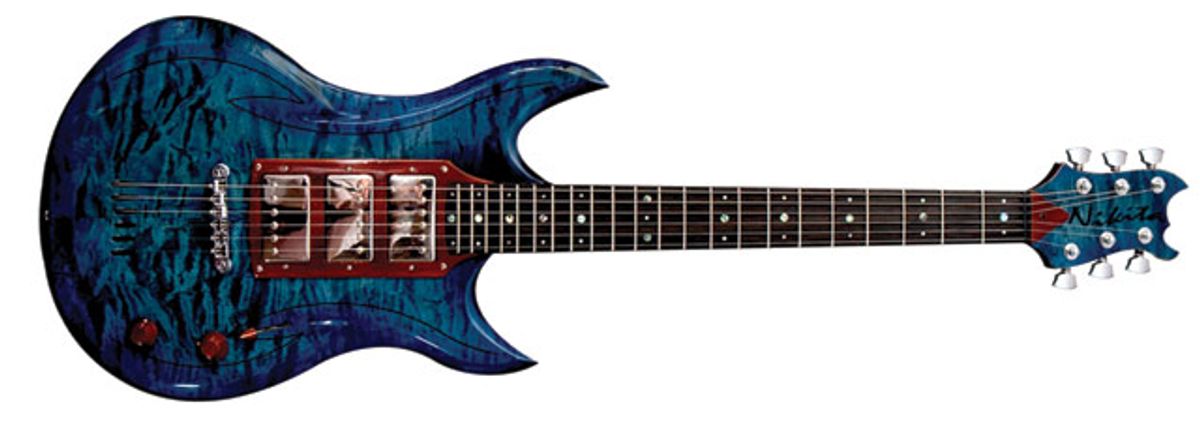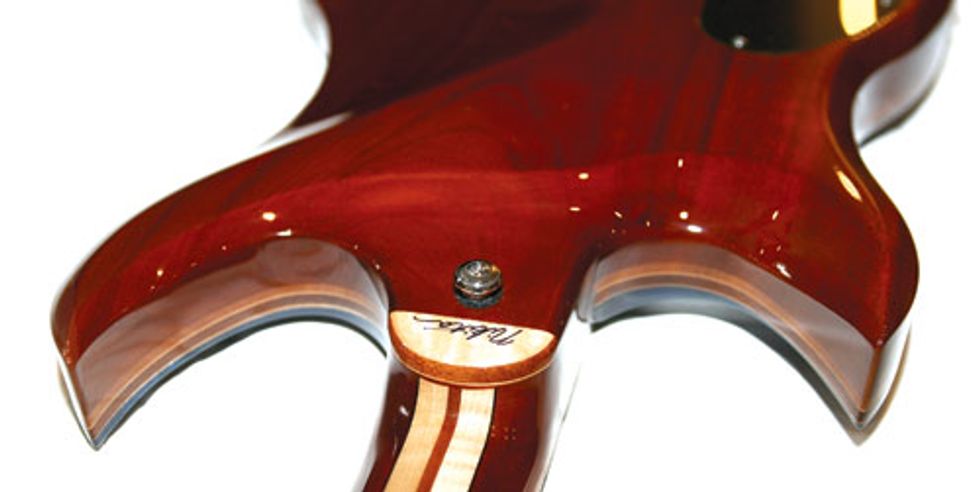
Nikita''s Classic is a high-end, hand-crafted beauty with some innovative design elements and some room for improvement.
| Download Example 1 Bridge Rock |
|
| Download Example 2 Neck and Middle |
|
| Download Example 3 Middle |
|
| Clips recorded with Nikita Classic through TomasZewicz 35112 with Lava Cable and Sony PCM-D50 recorder. |
|
When Fine Art Meets Fine Tone
Mellozzo’s creative and artistically inspired approach to luthiery stems from a family lineage rooted in the arts. His medium of choice is wood: he began first as a trained master woodworker, designing and creating custom cabinets for 20 years. Then, 10 years ago, he felt a calling and began to apply his woodworking skills to guitar building. After reverse-engineering countless project guitars acquired via eBay—combined with his 30-plus years as a player—Mellozzo’s self education in luthiery reached a level that led him to build his first Nikita. Since then, he’s focused on building unique, signature guitars. True to his artistic roots, none are exactly replicated, making each Nikita truly one of a kind.
The Nikita Classic, with its highly figured tonewood laminates, intricate inlays and triple humbuckers, appears at first to give a nod to the creations of Alembic, Cripe and Irwin. Looking closely at the degree of craftsmanship and thoughtful design decisions that went into the guitar’s construction, it’s hard not to be impressed. Every design decision, executed by hand, seems to blend together, creating a balanced instrument that can stand on its own. The Classic features a body comprised of a laminate of mahogany, rosewood and maple that gives the guitar an attractive appearance and prominent acoustic tone. The one-piece, solid mahogany back is more than 20 years old, features a tummy cut and is finished with three coats of urethane in an opaque brown vintage tint. Atop the mahogany body sits a 1/8" rosewood slab followed by a 3/8", two-piece bookmatched figured maple top. The top is finished in a very subtle blue burst (yes, I know that sounds like an oxymoron) that starts with an aqua hue and darkens to a Caribbean blue that accentuates the beveled edge of the top—which is carved in perfect unison with the dual ebony carved pinstripes that frame the top. Overall, it’s an impressive feat of craftsmanship.

Likewise, through the expert use of taping, the sides of the guitar give off the appearance of having a six-layer, wood-striped binding from the three wood types used in the laminate body. This deft execution of scraped binding also adorns the fretboard and headstock. The urethane-finished neck is also an attractive tonewood laminate, featuring five layers in total and comprised of mahogany, curly maple and wenge. The neck is topped with 22 6105-sized nickel-silver frets, and features an ample ebony fingerboard with shell dot inlays best described as “companion dots.” The headstock shape approximates the body profile and features a figured maple matching headstock veneer. The hand-shaped, 12"-radius neck has the feel of a ’59-style carve, but with a little more taper. It meets the body at the 15th fret. The dual-action truss rod is accessed at the headstock through a handcarved rosewood and maple cover.
The guitar is voiced with three chrome-covered Lindy Fralin Humbuckers—a 7.5K Pure PAF model in the neck, a 13.5K High Output Humbucker model in the middle and an 8.0K Pure PAF model in the bridge. This seemingly unorthodox pickup combination of vintage and high-output models is another smart design decision. To enhance playability, Mellozzo purposely lowered the hotter middle pickup to create more picking space while maintaining output balance amongst the pickups. The humbuckers are wired to a 5-way Switchcraft switch as follows: pos. 1, bridge, full humbucking, series; pos. 2, neck and middle, both pickups full humbucking, parallel; pos. 3, middle, full humbucking, series; pos. 4, neck and middle, both pickups full humbucking, parallel; and pos. 5, neck pickup, full humbucking, series. I’m a fan of unsplit humbucker combinations and was glad to see them incorporated in the Classic’s design. That said, I did experience volume loss in positions 2 and 4, which according to Mellozzo has been addressed on new guitars going forward.
The guitar has some innovative design elements that are precisely executed. For example, the strings are strung through the lower end of the instrument at a 12-degree pitch to match the 12-degree pitch of the headstock. The added six inches of string length and symmetrical string pull certainly contribute to the resonance and sustain of the guitar. These sonic properties also appear to be augmented by the modified neck-through design, where the neck is set into the body up to the bridge prior to the top being installed. The handcarved rosewood and maple laminated control knobs, truss rod cover and pickup surrounds are nice design touches that are functional and add to the guitar’s attractive color palette. The strings pass over a chrome Tune-o-matic bridge and a 1-11/16" black Earvana nut, and anchor into a set of locking chrome Sperzel tuners. One of my few nits with the guitar was that I noticed some glue residue around the nut, which had some sharp edges that could’ve been softened. The chrome strap buttons pair well with the chrome Switchcraft sidemounted input jack. The size of the neck joint, along with the location of the strap button set into it, did hamper upper fret access, but it’s my understanding that Mellozzo is addressing both of these issues on future models. Lastly, the Nikita signature on the back of the neck joint is classy touch.
The high degree of craftsmanship embodied by the Classic model translates into an instrument that has exceptional natural sustain and tone. The guitar is lightweight, resonant and balanced in both sitting and standing positions. Strung up with a set of Thomastik-Infeld Power Brights (.010–.050), the guitar exhibits a prominent acoustic voice with a diversified frequency response from its combination of tone woods, giving the guitar a voice as unique as its design. Notes have ample bloom with a certain degree of immediacy that is likely contributed to by the 25.5" scale in conjunction with an ebony fingerboard. The neck has a comfortable, two-degree pitch that feels quite Gibson-esque and the fretwork is well executed.
Plugged into amps from Carr, Fender and TomasZewicZ, the Classic offers up an array of usable tones that are diverse enough to handle rock, blues and jazz applications. The guitar has excellent clarity and note separation, and it sits well in the mix, particularly in the lower mids. It also has a singing quality whereby single line notes simply hang for as long as you need them—a great attribute for a blues guitar. The humbucker combinations had a great blend of fatness and quack. While not as clear as a single-coil combination, they offer up an added harmonic complexity that gave the guitar more of an acoustic quality, perfect for fingerpicking. While I am a fan of Fralin PAFs for their ability to deliver classic humbucking tones with the right amount of airiness and bite, the High Ouput model in the middle position was a personal favorite. Its position and design gave it a thick, gritty quality that had more of a fundamental emphasis than the PAFs, making it a good choice for harder, classic rock-applications.
The Final Mojo
The Classic stands out as a top-notch guitar that solidly delivers in both the tone and looks departments. At a price of just under $10,000, one would need to recognize that a substantial portion of its value is derived from the degree of time and craftsmanship embodied in this handcrafted instrument. That said, with its broad tonal offerings and meticulous craftsmanship, it is an instrument worthy of consideration amongst guitarists who can appreciate fine art and fine tone in a single offering.
Buy if...
you share an equal appreciation for fine woods, handcraftsmanship and tone.
Skip if...
you don’t highly value a premium handcrafted instrument.
Rating...
|
MSRP $9989 (as tested) - Nitkita Guitars - nikitaguitars.com
|

